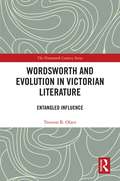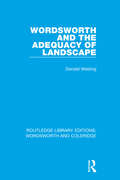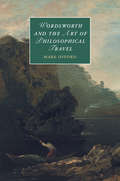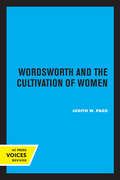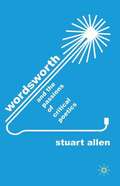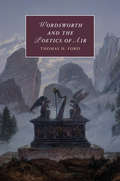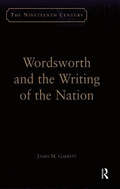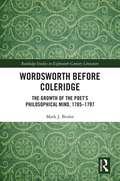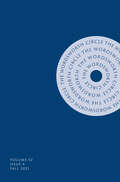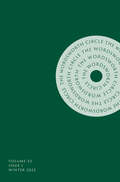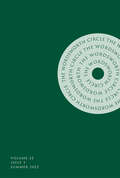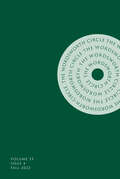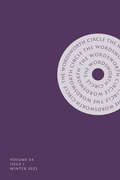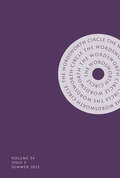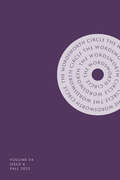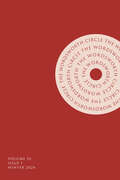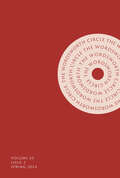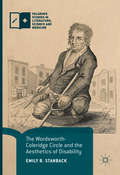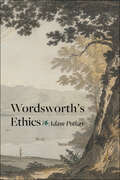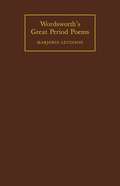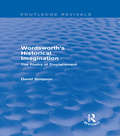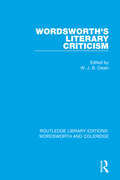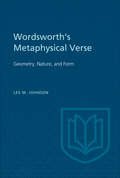- Table View
- List View
Wordsworth and Evolution in Victorian Literature: Entangled Influence (The Nineteenth Century Series)
by Trenton B. OlsenThe influences of William Wordsworth’s writing and evolutionary theory—the nineteenth century’s two defining visions of nature—conflicted in the Victorian period. For Victorians, Wordsworthian nature was a caring source of inspiration and moral guidance, signaling humanity's divine origins and potential. Darwin’s nature, by contrast, appeared as an indifferent and amoral reminder of an evolutionary past that demanded participation in a brutal struggle for existence. Victorian authors like Matthew Arnold, George Eliot, Robert Louis Stevenson, and Thomas Hardy grappled with these competing representations in their work. They turned to Wordsworth as an alternative or antidote to evolution, criticized and altered his poetry in response to Darwinism, and synthesized elements of each to propose their own modified theories. Darwin’s account of a material, evolutionary nature both threatened the Wordsworthian belief in nature’s transcendent value and made spiritual elevation seem more urgently necessary. Victorian authors used Wordsworth and Darwin to explore what form of transcendence, if any, could survive an evolutionary age, and reevaluated the purpose of literature in the process.
Wordsworth and the Adequacy of Landscape (RLE: Wordsworth and Coleridge #12)
by Donald WeslingFirst published in 1970, this stylistic and interpretative account of some of Wordsworth’s major poetry examines description and meditation in his landscape writing. It describes the integration of two kinds of thinking, and a variety of beauties and lapses that come from their separation. Although Wordsworth’s deepest affinity was with nature, the author argues the finest landscape writing of the poet’s late twenties and early thirties derives from his attempt to humanise his love of nature. This work therefore aims to examine the way in which Wordsworth strives in his poetry to extend his range of concern from love of nature to love of mankind.
Wordsworth and the Art of Philosophical Travel (Cambridge Studies in Romanticism)
by Mark OffordAt the heart of Wordsworth's concerns is the question of how travel - both foreign and everyday - might also become an adventure into philosophy itself. This is an art of travel both as an approach to experience - one that draws on habits in order to revise them in the shock of new - and as a poetic approach that gives voice to the singular and foreign through the unique shapes of verse. Close readings of Wordsworth's 'pictures of Nature, Man, and Society' show how the natural is entangled with - and not simply opposed to, as many critics have suggested - the social, the political and the historical in this verse. This book draws on both eighteenth-century anthropology and travel literature, and debates in modern critical theory, to highlight Wordsworth's remarkable originality and his ongoing ability to transform our theoretical prejudgements in the unknown territory of the travel encounter.
Wordsworth and the Cultivation of Women
by Judith W. PageFocusing on the poems of Wordsworth's "Great Decade," feminist critics have tended to see Wordsworth as an exploiter of women and "feminine" perspectives. In this original and provocative book, Judith Page examines works from throughout Wordsworth's long career to offer a more nuanced feminist account of the poet's values. She asks questions about Wordsworth and women from the point of view of the women themselves and of eighteenth- and nineteenth-century culture. Making extensive use of family letters, journals, and other documents, as well as unpublished material by the poet's daughter Dora Wordsworth, Page presents Wordsworth as a poet not defined primarily by egotistical sublimity but by his complicated and conflicted endorsement of domesticity and familial life. This title is part of UC Press's Voices Revived program, which commemorates University of California Press's mission to seek out and cultivate the brightest minds and give them voice, reach, and impact. Drawing on a backlist dating to 1893, Voices Revived makes high-quality, peer-reviewed scholarship accessible once again using print-on-demand technology. This title was originally published in 1994.
Wordsworth and the Enlightenment Idea of Pleasure
by Rowan BoysonAncient questions about the causes and nature of pleasure were revived in the eighteenth century with a new consideration of its ethical and political significance. Rowan Boyson reminds us that philosophers of the Enlightenment, unlike modern thinkers, often represented pleasure as shared rather than selfish, and she focuses particularly on this approach to the philosophy and theory of pleasure. Through close reading of Enlightenment and Romantic texts, in particular the poetry and prose of William Wordsworth, Boyson elaborates on this central theme. Covering a wide range of texts by philosophers, theorists and creative writers from over the centuries, she presents a strong defence of the Enlightenment ideal of pleasure, drawing out its rich political, as well as intellectual and aesthetic, implications.
Wordsworth and the Passions of Critical Poetics
by Stuart AllenThis scholarly study presents a new political Wordsworth: an artist interested in 'autonomous' poetry's redistribution of affect. No slave of Whig ideology, Wordsworth explores emotion for its generation of human experience and meaning. He renders poetry a critical instrument that, through acute feeling, can evaluate public and private life.
Wordsworth and the Poetics of Air (Cambridge Studies in Romanticism #121)
by Thomas H. FordBefore the ideas we now define as Romanticism took hold the word 'atmosphere' meant only the physical stuff of air; afterwards, it could mean almost anything, from a historical mood or spirit to the character or style of an artwork. Thomas H. Ford traces this shift of meaning, which he sees as first occurring in the poetry of William Wordsworth. Gradually 'air' and 'atmosphere' took on the new status of metaphor as Wordsworth and other poets re-imagined poetry as a textual area of aerial communication - conveying the breath of a transitory moment to other times and places via the printed page. Reading Romantic poetry through this ecological and ecocritical lens Ford goes on to ask what the poems of the Romantic period mean for us in a new age of climate change, when the relationship between physical climates and cultural, political and literary atmospheres is once again being transformed.
Wordsworth and the Writing of the Nation (The\nineteenth Century Ser.)
by James M. GarrettShedding fresh light on Wordsworth's contested relationship with an England that changed dramatically over the course of his career, James Garrett places the poet's lifelong attempt to control his literary representation within the context of national ideas of self-determination represented by the national census, national survey, and national museum. Garrett provides historical background on the origins of these three institutions, which were initiated in Britain near the turn of the nineteenth century, and shows how their development converged with Wordsworth's own as a writer. The result is a new narrative for Wordsworth studies that re-integrates the early, middle, and late periods of the poet's career. Detailed critical discussions of Wordsworth's poetry, including works that are not typically accorded significant attention, force us to reconsider the usual view of Wordsworth as a fading middle-aged poet withdrawing into the hills. Rather, Wordsworth's ceaseless reworking of earlier poems and the flurry of new publications between 1814 and 1820 reveal Wordsworth as an engaged public figure attempting to 'write the nation' and position himself as the nation's poet.
Wordsworth Before Coleridge: The Growth of the Poet’s Philosophical Mind, 1785-1797 (Routledge Studies in Eighteenth-Century Literature)
by Mark J. BruhnDrawing extensively upon archival resources and manuscript evidence, Wordsworth Before Coleridge rewrites the early history of Wordsworth’s intellectual development and thereby overturns a century-old consensus that derives his most important philosophical ideas from Coleridge. Beginning with Wordsworth’s mathematical and poetic studies at Hawkshead Grammar School and Cambridge University, both of which tutored the young poet in mind-matter dualism, the book charts the process by which Wordsworth came, not to reject this philosophical foundation, but to reevaluate the indispensable role of passion within it. Prompted by his reading in 1793 or early 1794 of Dugald Stewart’s Elements of the Philosophy of the Human Mind, Wordsworth rejected the exclusive rationality of William Godwin’s political philosophy and the anti-passionate morality of Alexander Pope’s philosophical poetics. Subsequent exposure, between 1795 and 1797, to Cambridge Platonism and English Kantianism supplied the key ideas of mind-nature fitness and multilevel psychological activity that, along with Stewart’s analysis of imaginative association, animate Wordsworth’s signature philosophy of "feeling intellect," from the initial drafts of The Pedlar and The Prelude in 1798 to the "Prospectus" to The Recluse and The Excursion, published together in 1814. By presenting for the first time a fully nuanced account of Wordsworth’s intellectual formation prior to the advent of Coleridge as his close companion and creative collaborator, Wordsworth Before Coleridge reveals at long last the true sources and abiding originality of the poet’s philosophical mind.
The Wordsworth Circle, volume 52 number 4 (Autumn 2021)
by The Wordsworth CircleThis is volume 52 issue 4 of The Wordsworth Circle. The Wordsworth Circle (TWC) is an international quarterly learned journal founded in 1970 to facilitate communications among colleagues interested in the lives, works, and times of British, American, and European writers from 1770 to 1850, before and after. TWC publishes original essays, conference papers, letters, editions, bibliographies, textual and historical scholarship, biography, interpretive criticism, and critical theory, as well as interdisciplinary, cultural, and comparative studies. It is concerned with anything that influenced, impinges upon, expresses, or contributes to an understanding of the writers, works, and events associated with Romantic studies and its after-lives.
The Wordsworth Circle, volume 53 number 1 (Winter 2022)
by The Wordsworth CircleThis is volume 53 issue 1 of The Wordsworth Circle. The Wordsworth Circle (TWC) is an international quarterly learned journal founded in 1970 to facilitate communications among colleagues interested in the lives, works, and times of British, American, and European writers from 1770 to 1850, before and after. TWC publishes original essays, conference papers, letters, editions, bibliographies, textual and historical scholarship, biography, interpretive criticism, and critical theory, as well as interdisciplinary, cultural, and comparative studies. It is concerned with anything that influenced, impinges upon, expresses, or contributes to an understanding of the writers, works, and events associated with Romantic studies and its after-lives.
The Wordsworth Circle, volume 53 number 2 (Spring 2022)
by The Wordsworth CircleThis is volume 53 issue 2 of The Wordsworth Circle. The Wordsworth Circle (TWC) is an international quarterly learned journal founded in 1970 to facilitate communications among colleagues interested in the lives, works, and times of British, American, and European writers from 1770 to 1850, before and after. TWC publishes original essays, conference papers, letters, editions, bibliographies, textual and historical scholarship, biography, interpretive criticism, and critical theory, as well as interdisciplinary, cultural, and comparative studies. It is concerned with anything that influenced, impinges upon, expresses, or contributes to an understanding of the writers, works, and events associated with Romantic studies and its after-lives.
The Wordsworth Circle, volume 53 number 3 (Summer 2022)
by The Wordsworth CircleThis is volume 53 issue 3 of The Wordsworth Circle. The Wordsworth Circle (TWC) is an international quarterly learned journal founded in 1970 to facilitate communications among colleagues interested in the lives, works, and times of British, American, and European writers from 1770 to 1850, before and after. TWC publishes original essays, conference papers, letters, editions, bibliographies, textual and historical scholarship, biography, interpretive criticism, and critical theory, as well as interdisciplinary, cultural, and comparative studies. It is concerned with anything that influenced, impinges upon, expresses, or contributes to an understanding of the writers, works, and events associated with Romantic studies and its after-lives.
The Wordsworth Circle, volume 53 number 4 (Autumn 2022)
by The Wordsworth CircleThis is volume 53 issue 4 of The Wordsworth Circle. The Wordsworth Circle (TWC) is an international quarterly learned journal founded in 1970 to facilitate communications among colleagues interested in the lives, works, and times of British, American, and European writers from 1770 to 1850, before and after. TWC publishes original essays, conference papers, letters, editions, bibliographies, textual and historical scholarship, biography, interpretive criticism, and critical theory, as well as interdisciplinary, cultural, and comparative studies. It is concerned with anything that influenced, impinges upon, expresses, or contributes to an understanding of the writers, works, and events associated with Romantic studies and its after-lives.
The Wordsworth Circle, volume 54 number 1 (Winter 2023)
by The Wordsworth CircleThis is volume 54 issue 1 of The Wordsworth Circle. The Wordsworth Circle (TWC) is an international quarterly learned journal founded in 1970 to facilitate communications among colleagues interested in the lives, works, and times of British, American, and European writers from 1770 to 1850, before and after. TWC publishes original essays, conference papers, letters, editions, bibliographies, textual and historical scholarship, biography, interpretive criticism, and critical theory, as well as interdisciplinary, cultural, and comparative studies. It is concerned with anything that influenced, impinges upon, expresses, or contributes to an understanding of the writers, works, and events associated with Romantic studies and its after-lives.
The Wordsworth Circle, volume 54 number 3 (Summer 2023)
by The Wordsworth CircleThis is volume 54 issue 3 of The Wordsworth Circle. The Wordsworth Circle (TWC) is an international quarterly learned journal founded in 1970 to facilitate communications among colleagues interested in the lives, works, and times of British, American, and European writers from 1770 to 1850, before and after. TWC publishes original essays, conference papers, letters, editions, bibliographies, textual and historical scholarship, biography, interpretive criticism, and critical theory, as well as interdisciplinary, cultural, and comparative studies. It is concerned with anything that influenced, impinges upon, expresses, or contributes to an understanding of the writers, works, and events associated with Romantic studies and its after-lives.
The Wordsworth Circle, volume 54 number 4 (Autumn 2023)
by The Wordsworth CircleThis is volume 54 issue 4 of The Wordsworth Circle. The Wordsworth Circle (TWC) is an international quarterly learned journal founded in 1970 to facilitate communications among colleagues interested in the lives, works, and times of British, American, and European writers from 1770 to 1850, before and after. TWC publishes original essays, conference papers, letters, editions, bibliographies, textual and historical scholarship, biography, interpretive criticism, and critical theory, as well as interdisciplinary, cultural, and comparative studies. It is concerned with anything that influenced, impinges upon, expresses, or contributes to an understanding of the writers, works, and events associated with Romantic studies and its after-lives.
The Wordsworth Circle, volume 55 number 1 (Winter 2024)
by The Wordsworth CircleThis is volume 55 issue 1 of The Wordsworth Circle. The Wordsworth Circle (TWC) is an international quarterly learned journal founded in 1970 to facilitate communications among colleagues interested in the lives, works, and times of British, American, and European writers from 1770 to 1850, before and after. TWC publishes original essays, conference papers, letters, editions, bibliographies, textual and historical scholarship, biography, interpretive criticism, and critical theory, as well as interdisciplinary, cultural, and comparative studies. It is concerned with anything that influenced, impinges upon, expresses, or contributes to an understanding of the writers, works, and events associated with Romantic studies and its after-lives.
The Wordsworth Circle, volume 55 number 2 (Spring 2024)
by The Wordsworth CircleThis is volume 55 issue 2 of The Wordsworth Circle. The Wordsworth Circle (TWC) is an international quarterly learned journal founded in 1970 to facilitate communications among colleagues interested in the lives, works, and times of British, American, and European writers from 1770 to 1850, before and after. TWC publishes original essays, conference papers, letters, editions, bibliographies, textual and historical scholarship, biography, interpretive criticism, and critical theory, as well as interdisciplinary, cultural, and comparative studies. It is concerned with anything that influenced, impinges upon, expresses, or contributes to an understanding of the writers, works, and events associated with Romantic studies and its after-lives.
The Wordsworth-Coleridge Circle and the Aesthetics of Disability (Palgrave Studies in Literature, Science and Medicine)
by Emily B. StanbackThis book argues for the importance of disability to authors of the Wordsworth-Coleridge circle. By examining texts in a variety of genres -- ranging from self-experimental medical texts to lyric poetry to metaphysical essays -- Stanback demonstrates the extent to which non-normative embodiment was central to Romantic-era thought and Romantic-era aesthetics. The book reassesses well-known literary and medical works by such authors as William Wordsworth, Samuel Taylor Coleridge, and Humphry Davy, argues for the importance of lesser-studied work by authors including Charles Lamb and Thomas Beddoes, and introduces significant unpublished work by Tom Wedgwood.
Wordsworth's Ethics
by Adam PotkayA comprehensive examination that breathes new life into Wordsworth and the ethical concerns that were vital to his nineteenth-century readers.Why read Wordsworth’s poetry—indeed, why read poetry at all? Beyond any pleasure it might give, can it make one a better or more flourishing person? These questions were never far from William Wordsworth’s thoughts. He responded in rich and varied ways, in verse and in prose, in both well-known and more obscure writings.Wordsworth's Ethics is a comprehensive examination of the Romantic poet’s work, delving into his desire to understand the source and scope of our ethical obligations. Adam Potkay finds that Wordsworth consistently rejects the kind of impersonal utilitarianism that was espoused by his contemporaries James Mill and Jeremy Bentham in favor of a view of ethics founded in relationships with particular persons and things. The discussion proceeds chronologically through Wordsworth’s career as a writer—from his juvenilia through his poems of the 1830s and '40s—providing a valuable introduction to the poet’s work. The book will appeal to readers interested in the vital connection between literature and moral philosophy.
Wordsworth's Great Period Poems: Four Essays
by Marjorie LevinsonThe book presents four major poems from Wordsworth's great period of creativity, 1798-1805: Tintern Abbey, Michael, The Intimations Ode, Peele Castle.
Wordsworth's Historical Imagination: The Poetry of Displacement (Routledge Revivals)
by David SimpsonTraditionally, Wordsworth’s greatness is founded on his identity as the poet of nature and solitude. The Wordsworthian imagination is seen as an essentially private faculty, its very existence premised on the absence of other people. In this title, first published in 1987, David Simpson challenges this established view of Wordsworth, arguing that it fails to recognize and explain the importance of the context of the public sphere and the social environment to the authentic experience of the imagination. Wordsworth’s preoccupation with the metaphors of property and labour shows him to be acutely anxious about the value of his art in a world that he regarded as corrupted. Through close examination of a few important poems, both well-known and relatively unknown, Simpson shows that there is no unitary, public Wordsworth, nor is there a conflict or tension between the private and the public. The absence of any clear kind of authority in the voice that speaks the poems makes Wordsworth’s poetry, in Simpson’s phrase, a ‘poetry of displacement’.
Wordsworth's Literary Criticism (RLE: Wordsworth and Coleridge #13)
by W. J. B. OwenFirst published in 1974. Wordsworth, with Coleridge, is the major literary critic of the Romantic period. This volume assembles all of Wordsworth’s formal critical writings and a selection of critical comments from his correspondence. These documents are invaluable for Romantic poetry at large, and his theories — particularly on poetic diction, ordinary language and the nature of the creative process — inspired lively critical debate. This book discusses the nature and origin of Wordsworth’s criticism in general, and the literary tradition from which they sprang. The texts are succinctly annotated and there is a select bibliography. This book will be of interest to students of literature.
Wordsworth's Metaphysical Verse: Geometry, Nature, and Form
by Lee JohnsonIn his philosophic verse, Woodsworth identifies the history of poetry and geometrical thought as the two chief treasures of the mind and as main sources of his poetic inspiration. He assigns transcendental value to geometry and indicates that he attempts to apply its proportions to the laws of nature. In this book, Professor Johnson demonstrates how Wordsworth also employed geometrical patterns in the metrical construction of his verse and how the character of those patterns can be related to the poet's major philosophical values. Johnson shows how Wordsworth, when writing about the nature and significance of geometrical thought in The Prelude and The Excursion, designs his verse paragraphs in accordance with simple geometrical proportions which are thereby associated with the metaphysical value he attributes to geometry. Wordsworth finds geometrical forms to be hidden in the natural landscape and inherent in the structures of perception itself. This book is the first to make a sustained description of Wordsworth's symbolic patterns and metrical forms in his philosophic verse, with major examples drawn from Tintern Abbey, The Prelude, The Excursion, and the Immortality Ode. Although it presents an approach which differs radically from any in the established criticism of the poet, it is basically at one with the large body of work that concerns the nature of Wordsworth's imagination.
